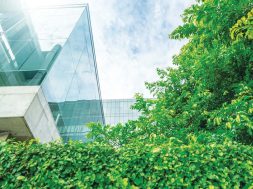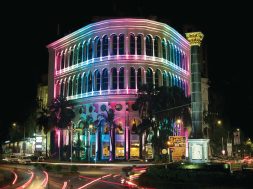Time has come to act to save our planetEnvironmental policies provide handhold guidance and direction toward green and sustainable development. Unless every individual doesn’t act on the policies, it won’t make any difference toward betterment of our environment
Mala Singh,Founder and Managing Director, PEC Solutions, Green Designs Pvt. Ltd., National Executive Committee Member, Indian Green Building Council (CII), andGreen Building Committee Member, Environment and Forest Department, Government of Gujarat
Green building movement in India is driven by the aspiration of private companies than legislation set by the government. There is no mandatory green building code or policy in India. There are certain voluntary rating systems which are based on the existing national codes like the Energy Conservation Building Code (ECBC) and National Building Code which facilitate the green building designing and construction in India. These rating systems in India are being promoted by agencies like Indian Green Building Council (CII) and GRIHA. These are the voluntary standards for green buildings development in India. However, the government has initiated to prioritise to get environmental clearance for pre-certified or certified projects by IGBC or GRIHA. These organisations envision to enable sustainable-built environment for all and facilitate India to be one of the global leaders in sustainable-built environment by 2025. Both organisations are coordinating consensus-based effort at national level to provide the industry with tools for designing, building, and operating buildings that deliver high performance inside.
With estimated 60 per cent of global energy consumption, the operation of buildings contributes more to energy use and climate change than either transportation or industry. To meet the emerging climate change and carbon challenge, the human settlement needs retrofitting. Real estate has been the major contributor toward the gradual environmental degradation of Indian cities. Developers need to find better, more sustainable methods of designing their buildings in order to reduce their negative environmental impact. It needs to be understood that the conventional method of constructing buildings as well as inhabiting such buildings are a major drain on the available resources like energy and water. These are also the largest contributor to greenhouse gas emissions. There was a time when we took great pride in Indian city’s unique ecosystems. The rich biodiversity can be found in its open spaces, forests, and water bodies. In real sense, Indian cities were green, but now due to unplanned development, we are all surrounded by concrete jungle in our cities. We need to adopt very important criteria of “urban forest” for transforming our cities into healthy, vibrant cities. Landscape and township ratings of Indian Green Building council and large area development rating system of GRIHA can help create “Urban Forest” in urban areas. We also need green infrastructure, green buildings, and sustainable habitats altogether for overall quality of life.
We hear and read about the detriments of climate change and yet, the whole concept of environmental sustainability remains an abstract, confusing concept to most of the individuals and even to the stakeholders of our construction industry. This is due to the lack of awareness among various stakeholders, especially the common man and developers who develop their projects with conventional approach. More and more awareness of sustainability and green development concept can help understand what is green and why we need green? Even green education from grass-root level may contribute a lot for better tomorrow.
Under the government policy of EIA Notification 2006 of the Ministry of Environment and Forest, environmental clearance is mandatory for all new construction and infrastructure projects. This approval copy of environmental clearance consists of various conditions to comply for making environmental infrastructure as an integral part of the project. The rate of successful implementation of these mandatory compliances is still not known or not possible to evaluate because of unavailability of well-defined strategies and monitoring mechanisms. Commitments to follow these conditions have no value until it’s not executed on ground. Main agenda remains just to get the environmental clearance from the concerned authority so construction can be started.
Policy on paper will not be sufficient for sustainable development, which is the need of the hour due to current scenario of global warming and climate change. All the stakeholders need to understand individual social responsibility to tackle the situation; hence implementation and action should be on priority during the development process.While doing so, perhaps the most important thing to remember is that sustainability is not below in-line item (need to be treated “first thought” in the mind). When establishing a design and budget for a sustainable building, the key point to remember is that sustainability is a program issue rather than an added requirement. The perception of additional cost is always a main hurdle in the way of development of green building. It has been observed that there is no additional cost of green building if this concept is well considered in the basic planning stage itself. Also project team should have thorough knowledge of green and sustainable parameters and the capability to incorporate and integrate these features in the planning stage of design.
Green building development can be brought into execution by establishing team goals, expectations and expertise (architect, environmental planner, MEP expert, landscape and site analyst, etc.). We need the complete team on board to start design, including specific goals in the program like aligning budget with program, staying on track through design, and executing the same on ground during construction.
One should understand that sustainable design tends to reduce the environmental, health impacts and cost associated with environmental pollution. Simply, sustainable green development saves money by lowering down operation and maintenance cost (reduction in water and energy bills), optimising energy performance, improving productivity, reduce regulatory risks, and contributing to the green economy of the nation.
Thus, after understanding several benefits of green development for planet, people and never the less from profit point of view, one shouldn’t wait for government or other agencies to take action on ground. All of us need to innovate our own agenda for sustainable development. Hence, social responsibility comes into the picture here. All need to contribute their part through several small initiatives, which can eventually lead to a remarkable achievement toward the goal of green and sustainable development.
There is no point in cutting down trees to write lengthy environmental policies on paper or making lengthy EIA reports or various other documentation procedures. One should understand the value of implementing the required actions on ground to save our planet. If followed strategically, environmental policies provide handhold guidance and direction toward green and sustainable development. However, unless every individual doesn’t care to take the guidance sand step toward green, the policies can’t make any difference toward betterment of our environment.
Therefore, the time has come when the government and policy makers should put forth policies and implementation strategies, including effective monitoring mechanisms from which every individual or stakeholder can get inspired as well as guided and will start acting on ground toward green and sustainable development immediately. A little delay in our actions will put ourselves and our future generation’s existence in danger, so wake up and take action.
Cookie Consent
We use cookies to personalize your experience. By continuing to visit this website you agree to our Terms & Conditions, Privacy Policy and Cookie Policy.









